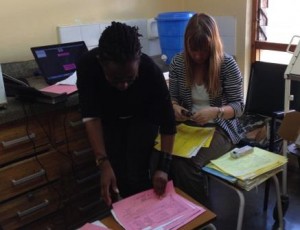Yesterday, I went with the travelling team to the Zomba Central Hospital. Our main goal was to scan patient charts from February to May for patients who were on Oxygen or CPAP. While Shannon and Carol got working in the office (the currently unused isolation room), Aakash and I rounded on our patients: the CPAPs and Oxygen Concentrators. Along with taking inventory of CPAP supplies, we had to swap out a two of the four CPAPs that were not working.
For the most part, I would say that this first trip opened my eyes to a new side of implementation: paperwork. In GLHT 360, Dr. Richards-Kortum talked to us about how the engineering design process involves much more than just coming up with a good prototype, but the trip to Zomba was a first-hand experience that helped it sink in. It was a good dose of realism.

Our paperwork consisted of going through the patient charts and scanning the doctor’s notes to find out how many days each patient had been on Oxygen or CPAP. After they are scanned, a subset of the charts will be reviewed by a doctor at Queens to verify that the diagnosis was correct. Collecting this data seems tedious at times, but at the same time it is a little bit exciting: the information I am helping to gather is helping babies survive.
On a side note, when I become a doctor, I hope my handwriting doesn’t look like that 🙂
At the same time, it was also a very encouraging trip. The in-charge nurse we met with said they had recently had a CPAP training with 40 nurses! This is really important because one of the problems with implementation is that only a small set of nurses know how to use the CPAP and they may or may not be on duty at the needed time.